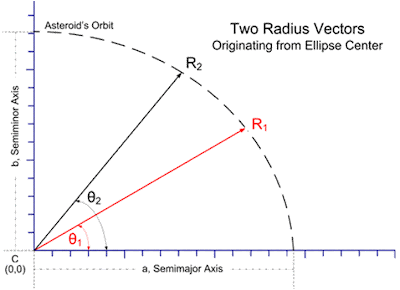 | | Angle | Y=mX | X-value | Y-value | | | |
|---|
| θ | Slope (m) | r*Cosθ | r*Sinθ | | | |
|---|
| (Deg) | Tanθ | Cosθ | Sinθ | Tan2θ | Cos2θ | Sin2θ |
|---|
| 0° | 0 | 1 | 0 | 0 | 1 | 0 | | 30° | 1/√3 | √3 / 2 | 1/2 | 1/3 | 3/4 | 1/4 | | 45° | 1 | √2 / 2 | √2 / 2 | 1 | 1/2 | 1/2 | | 60° | √3 | 1/2 | √3 / 2 | 3 | 1/4 | 3/4 | | 90° | ∞ | 0 | 1 | ∞ | 0 | 1 | | | | | | | | | | | | | | | | 0° | 0 | 1 | 0 | 0 | 1 | 0 | | 26.565° | 1 / 2 | 2/√5 | 1/√5 | 1/4 | 4/5 | 1/5 | | 45° | 1 | √2 / 2 | √2 / 2 | 1 | 1/2 | 1/2 | | 63.435° | 2 | 1/√5 | 2/√5 | 4 | 1/5 | 4/5 | | 90° | ∞ | 0 | 1 | ∞ | 0 | 1 | | | | | | | | Examples of convenient trigonometric ratios.
|
|
|---|
| | | | | |
| | | | | |
| Ellipse Equation |
| Recall we're looking for intersection of line and ellipse. Thus, substitute line equation (y=mx, slope times x) into term containing "y". |
| | | | |
Solve for a-a2 b2 | + | a2m2x2 | = | -x2b2 | a2 * (-b2 | + | m2x2) | = | -x2b2 | a2 * (b2 | - | m2x2) | = | x2b2 | | Solve for b-a2 b2 | + | b2x2 | = | -m2x2a2 | b2 * (-a2 | + | x2) | = | -m2x2a2 | b2 * (a2 | - | x2) | = | m2x2a2 | | | | | |
| | | | | |
| | | | | |
Assume 1st vector, (r1, θ1):a | = | r1cos(θ1)b
√(b2 - tan2(θ1)r12cos2(θ1)) | | | | Assume 2nd vector, (r2, θ2):b | = | tan(θ2)r2cos(θ2)a
√(a2 - r22cos2(θ2)) | | | | Make following substitutions:
m = tan(θ)
x = rcos(θ)
|
a | = | b * r1 * cos(θ1)
√(b2 - r12sin2(θ1)) | | |
| b | = | a * r2 * sin(θ2)
√(a2 - r22cos2(θ2)) | | |
| Note following trig identity:
tan(θ) = sin(θ) / cos(θ)
Therefore,
tan(θ) cos(θ) = sin(θ) |
a2 | = | b2 * r12 * cos2(θ1)
b2 - r12sin2(θ1) | | |
| b2 | = | a2 * r22 * sin2(θ2)
a2 - r22cos2(θ2) | | |
| |
b2 * x12
b2 - y12 | | = a2 = | b2 * x22
b2 - y22 | | |
| | | a2 * y12
a2 - x12 | | = b2 = | a2 * y22
a2 - x22 | | |
| Since both radius vectors cross same ellipse, they can be used interchangeably as shown.
Transitive identity property allow two outside expressions to equal b2 as well as each other. |
x12
b2 - y12 | | = | x22
b2 - y22 | | |
| | | y12
a2 - x12 | | = | y22
a2 - x22 | | |
| Deleting common term from both sides, above equations can be written as shown. |
x12(b2 - y22) | | = | x22(b2 - y12) |
x12b2 - x12y22 | | = | x22b2 - x22y12 |
x12b2 - x22b2 | | = | x12y22 - x22y12 |
b2(x12 - x22) | | = | x12y22 - x22y12 |
| | | y12 (a2 - x22) | = | y22(a2 - x12) | | |
| | y12a2 - y12x22 | = | y22a2 - y22x12 | | |
| | y12a2 - y22a2 | = | y12x22 - y22x12 | | |
| | a2(y12 - y22) | = | y12x22 - y22x12 | | |
| Rearrange as shown. |
b2 | = | x12y22 - x22y12
x12 - x22 |
| a2 | = | y12x22 - y22x12
y12 - y22 |
| FINALLY!!! We've isolated terms a2 and b2.
We can now substitute arbitrary values as shown in next row. |
b2 | = | 0.54 AU2AU2 - 0.18AU2AU2
0.333 AU2 |
| a2 | = | (0.18AU2 - 0.54 AU2)AU2
-0.107 AU2 |
| Arbitrary Example:
Recall restriction r1 = 1.2 AU | θ1 = 30° | r2 = 1.0 AU | θ2=45° | Recall substitutions | x1 =1.04AU | y1=.600AU | x2= .707AU | y2=.707AU | x12=1.08AU2 | y12=.36AU2 | x22=.5AU2 | y22=.5AU2 | x12y22 = 0.54 AU2AU2 | x22y12= 0.18 AU2AU2 | x12 - x22 = 0.333 AU2 | y12 - y22= -0.107 AU2 |
|
For this entirely arbitrary example of two radius vectors from elliptic center to elliptic perimeter, we have calculated values for semimajor axis, a, and semiminor axis, b, to determine elliptic equation.
These vectors were limited only by convenience and a few common sense restrictions.
We can use now use values for a and b to calculate:



0 Comments:
Post a Comment
<< Home